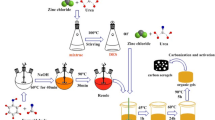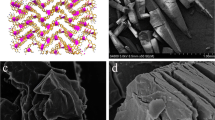Abstract
Activated nitrogen-doped carbons (ANCs) were prepared by carbonization/activation approach using aminated polyvinyl chloride (PVC) as precursor. ANCs exhibit larger porosities and higher specific surface areas than those of their nitrogen-free counterparts for the same KOH/carbon ratio. The specific surface area of ANC-1 is up to 1,398 m2 g−1 even at a low KOH/carbon ratio of 1:1. Fourier transform infrared spectroscopy investigation of the nitrogen-enriched resin precursor indicates the efficient dehydrochlorination of PVC by ethylenediamine at a low temperature. The nitrogen content and the population of nitrogen functionalities strongly depend on the KOH/carbon ratios and decrease drastically after KOH activation as seen from the elemental and X-ray photoelectron spectroscopy analysis. The surface concentration of N-6 and N-Q almost disappears and the dominant nitrogen groups become N-5 after KOH activation. The highest specific capacitance of ANCs is up to 345 F g−1 at a current density of 50 mA g−1 in 6 M KOH electrolyte. ANCs also exhibit a good capacitive behavior at a high scan rate of 200 mV s−1 and an excellent cyclability with a capacitance retention ratio as high as ∼93 % at a current density of 2,000 mA g−1 for 5,000 cycles.







Similar content being viewed by others
References
Simon P, Gogotsi Y (2008) Materials for electrochemical capacitors. Nat Mater 7:845–854
Frackowiak E, Béguin F (2001) Carbon materials for the electrochemical storage of energy in capacitors. Carbon 39:937–950
Pandolfo AG, Hollenkamp AF (2006) Carbon properties and their role in supercapacitors. J Power Sources 157:11–27
Hulicova-Jurcakova D, Seredych M, Lu GQ, Bandosz TJ (2009) Combined effect of nitrogen- and oxygen-containing functional groups of microporous activated carbon on its electrochemical performance in supercapacitors. Adv Funct Mater 19:438–447
Frackowiak E (2007) Carbon materials for supercapacitor application. Phys Chem Chem Phys 9:1774–1785
Zhang LL, Zhao XS (2009) Carbon-based materials as supercapacitor electrodes. Chem Soc Rev 38:2520–2531
Inagaki M, Konno H, Tanaike O (2010) Carbon materials for electrochemical capacitors. J Power Sources 195:7880–7903
Zhai Y, Dou Y, Zhao D, Fulvio PF, Mayes RT, Dai S (2011) Carbon materials for chemical capacitive energy storage. Adv Mater 23:4828–4850
Jurewicz K, Babeł K, Źiółkowski A, Wachowska H (2003) Ammoxidation of active carbons for improvement of supercapacitor characteristics. Electrochim Acta 48:1491–1498
Hulicova D, Yamashita J, Soneda Y, Hatori H, Kodama M (2005) Supercapacitors prepared from melamine-based carbon. Chem Mater 17:1241–1247
Zhao L, Fan LZ, Zhou MQ, Guan H, Qiao SY, Antonietti M, Titirici MM (2010) Nitrogen-containing hydrothermal carbons with superior performance in supercapacitors. Adv Mater 22:5202–5206
Qiao WM, Yoon SH, Mochida I, Yang JH (2007) Waste polyvinylchloride derived pitch as a precursor to develop carbon fibers and activated carbon fibers. Waste Manage 27:1884–1890
Lingaiah N, Uddin MA, Morikawa K, Muto A, Murata K, Sakata Y (2001) Catalytic dehydrochlorination of chloro-organic compounds from PVC containing waste plastics derived fuel oil over FeCl2/SiO2 catalyst. Green Chem 3:74–75
Ahmad Z, Manzoor W (1992) Thermogravimetric analysis of ZnCl2 catalyzed degradation of PVC. J Therm Anal Calorim 38:2349–2357
McNeill IC, Memetea L, Cole WJ (1995) A study of the products of PVC thermal degradation. Polym Degrad Stabil 49:181–191
Dietrich B (2002) Recycling of PVC. Prog Polym Sci 27:2171–2195
Iguchi K, Tsunoda R, Takeshit S (1974) Preparation of activated carbon from polyvinyl-chloride. Int Chem Eng 14:381–385
Qiao WM, Song Y, Yoon SH, Korai Y, Mochida I, Yoshiga S, Fukuda H, Yamazaki A (2006) Carbonization of waste PVC to develop porous carbon material without further activation. Waste Manage 26:592–598
Lian F, Xing BS, Zhu LY (2011) Comparative study on composition, structure, and adsorption behavior of activated carbons derived from different synthetic waste polymers. J Colloid Interface Sci 360:725–730
Yan J, Wei T, Shao B, Fan Z, Qian W, Zhang M, Wei F (2010) Preparation of a graphene nanosheet/polyaniline composite with high specific capacitance. Carbon 48:487–493
Chmiola J, Yushin G, Gogotsi Y, Portet C, Simon P, Taberna PL (2006) Anomalous increase in carbon capacitance at pore sizes less than 1 nanometer. Science 313:1760–1763
Fey GTK, Lee DC, Lin YY, Kumar TP (2003) High-capacity disordered carbons derived from peanut shells as lithium-intercalating anode materials. Synthetic Met 139:71–80
Bonhomme F, Lassègues JC, Servant L (2001) Raman spectroelectrochemistry of a carbon supercapacitor. J Electrochem Soc 148:E450–E458
Muraliganth T, Stroukoff KR, Manthiram A (2010) Microwave-solvothermal synthesis of nanostructured Li2MSiO4/C (M = Mn and Fe) cathodes for lithium-ion batteries. Chem Mater 22:5754–5761
Lozano-Castelló D, Lillo-Ródenas MA, Cazorla-Amorós D, Linares-Solano A (2001) Preparation of activated carbons from Spanish anthracite I. Activation by KOH Carbon 39:741–749
Alonso A, Ruiz V, Blanco C, Santamaría R, Granda M, Menéndez R, de Jager SGE (2006) Activated carbon produced from Sasol-Lurgi gasifier pitch and its application as electrodes in supercapacitors. Carbon 44:441–446
Kryazhev YG, Solodovnichenko VS, Antonicheva NV, Gulyaeva TI, Drozdov VA, Likholobov VA (2009) Evolution of the structures and sorption properties of dehydrochlorinated chloropolymers during their thermal conversions. Prot Met Phys Chem 45:398–402
Mitani S, Lee SI, Yoon SH, Korai Y, Mochida I (2004) Activation of raw pitch coke with alkali hydroxide to prepare high performance carbon for electric double layer capacitor. J Power Sources 133:298–301
Jiang J, Gao Q, Xia K, Hu J (2009) Enhanced electrical capacitance of porous carbons by nitrogen enrichment and control of the pore structure. Micropor Mesopor Mater 118:28–34
Lillo-Ródenas MA, Cazorla-Amorós D, Linares-Solano A (2003) Understanding chemical reactions between carbons and NaOH and KOH: an insight into the chemical activation mechanism. Carbon 41:267–275
Zeng XH, Wu DC, Fu RW, Lai HJ, Fu JJ (2008) Preparation and electrochemical properties of pitch-based activated carbon aerogels. Electrochim Acta 53:5711–5715
Xue R, Shen Z (2003) Formation of graphite-potassium intercalation compounds during activation of MCMB with KOH. Carbon 41:1862–1864
Kakuta N, Shimizu A, Ohkita H, Mizushima T (2009) Dehydrochlorination behavior of polyvinyl chloride and utilization of carbon residue: effect of plasticizer and inorganic filler. J Mater Cycles Waste 11:23–26
Hong J-H, Hong S-K (2010) Preparation of anion exchange membrane by amination of chlorinated polypropylene and ethylenediamine and its properties. J Appl Polym Sci 115:2296–2301
Balakrishnan B, Kumar DS, Yoshida Y, Jayakrishnan A (2005) Chemical modification of poly(vinyl chloride) resin using poly(ethylene glycol) to improve blood compatibility. Biomaterials 26:3495–3502
Demir-Cakan R, Makowski P, Antonietti M, Goettmann F, Titirici M-M (2010) Hydrothermal synthesis of imidazole functionalized carbon spheres and their application in catalysis. Catal Today 150:115–118
Biniak S, Szymański G, Śiedlewski J, Swiatkowski A (1997) The characterization of activated carbons with oxygen and nitrogen surface groups. Carbon 35:1799–1810
Pels JR, Kapteijn F, Moulijn JA, Zhu Q, Thomas KM (1995) Evolution of nitrogen functionalities in carbonaceous materials during pyrolysis. Carbon 33:1641–1653
László K, Tombácz E, Josepovits K (2001) Effect of activation on the surface chemistry of carbons from polymer precursors. Carbon 39:1217–1228
Wang DW, Li F, Liu M, Lu GQ, Cheng HM (2008) 3D aperiodic hierarchical porous graphitic carbon material for high-rate electrochemical capacitive energy storage. Angew Chem 120:379–382
Moriguchi I, Nakahara F, Furukawa H, Yamada H, Kudo T (2004) Colloidal crystal-templated porous carbon as a high performance electrical double-layer capacitor material. Electrochem Solid St 7:A221–A223
Rufford TE, Hulicova-Jurcakova D, Zhu Z, Lu GQ (2008) Nanoporous carbon electrode from waste coffee beans for high performance supercapacitors. Electrochem Commun 10:1594–1597
Rufford TE, Hulicova-Jurcakova D, Khosla K, Zhu Z, Lu GQ (2010) Microstructure and electrochemical double-layer capacitance of carbon electrodes prepared by zinc chloride activation of sugar cane bagasse. J Power Sources 195:912–918
Raymundo-Piñero E, Kierzek K, Machnikowski J, Béguin F (2006) Relationship between the nanoporous texture of activated carbons and their capacitance properties in different electrolytes. Carbon 44:2498–2507
Seredych M, Hulicova-Jurcakova D, Lu GQ, Bandosz TJ (2008) Surface functional groups of carbons and the effects of their chemical character, density and accessibility to ions on electrochemical performance. Carbon 46:1475–1488
Acknowledgments
This work was supported by the National Natural Science Foundation of China (nos. 20836002, 21003016, and 21276045), the Dalian Science and Technology Bureau of China (no. 2011A15GX023), and China Postdoctoral Science Foundation (no. 20100481227).
Author information
Authors and Affiliations
Corresponding authors
Rights and permissions
About this article
Cite this article
Sun, L., Wang, C., Zhou, Y. et al. Activated nitrogen-doped carbons from polyvinyl chloride for high-performance electrochemical capacitors. J Solid State Electrochem 18, 49–58 (2014). https://doi.org/10.1007/s10008-013-2227-8
Received:
Revised:
Accepted:
Published:
Issue Date:
DOI: https://doi.org/10.1007/s10008-013-2227-8




